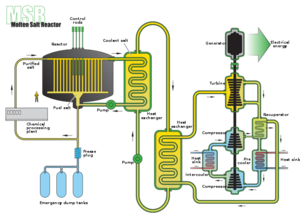
Over the past few decades there has been a growing interest in circulating fuel reactors (CFRs), especially molten salt reactors (MSRs). As the need for alternative energy sources grows, molten salt reactor designs may see an increase in use as they can generate large amounts of energy while being lower maintenance and much safer when compared to solid fuel reactors. However, there are a few issues with molten salt reactors. Due to the circulating fuel in molten salt reactors, safeguarding the fuel is more difficult than safeguarding the fuel in solid fuel reactors. Safeguarding the reactor and the fuel is imperative to a reactor's success as it helps keep the fuel out of the wrong hands. This project aims to model and run simulations on a molten salt reactor in order to determine potential diversion pathways based on the changes in reactor efficiency.
The project uses recently developed simulation code QuasiMolto, which was developed by Aaron Reynolds as a part of their dissertation. QuasiMotlo is a multiphysics solver for molten salt reactors that uses quasi-diffusion acceleration. QuasiMotlo solves for many values such as loss of reactivity from DNP flow, isothermal eigenvalue, fluxes, and temperatures. This project looks at temperatures and scalar fluxes in the fastest neutron group. The project aims to run simulations with varying levels of fuel volume in the model in order to represent someone diverting fuel from the reactor. The varying level of fuel volume occurs from the graphite moderating section in the fuel region increasing in size, by an increment of 5 cm. Average temperatures and scalar fluxes across the reactor were calculated and compared between the six simulations. Using these results, safeguard approaches will be developed to help ensure the safety of the fuel. Future work of the project will include looking towards other values that QuasiMolto solves for as well as inputting a finer geometry in QuasiMolto in order to represent a smaller incremental change in fuel volume.
| Attachment | Size |
|---|---|
| 695.46 KB |

